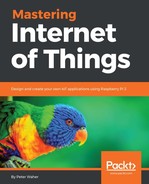Values we sample may include different types of errors, some of which we can eliminate in the code to various degrees. There are systematic errors and random errors. Systematic errors are most often caused by the way we've constructed our device, how we sample, how the circuit is designed, how the sensors are situated, how they interact with the physical medium and our underlying mathematical model, or how we convert the sampled value into a physical quantity. Reducing systematic errors requires a deeper analysis that goes beyond the scope of this book.
Random errors are errors that are induced stochastically and are often unbiased. They can be induced due to a lack of resolution or precision, by background noise, or through random events in the physical world. While background noise and the lack of resolution or precision in our electronics create a noise in the measured input, random events in the physical world may create spikes. If something briefly flutters past our light sensor, it might register a short downwards spike, even though the ambient light did not change. You'll learn how to correct for both types of random errors.
